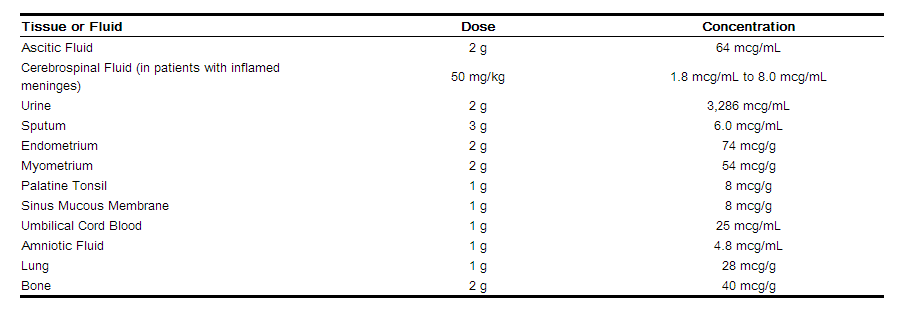Cefoperazone clinical pharmacology
Editor-In-Chief: C. Michael Gibson, M.S., M.D. [1];Associate Editor(s)-in-Chief: Abdurahman Khalil, M.D. [2]
High serum and bile levels of CEFOBID are attained after a single dose of the drug. Table 1 demonstrates the serum concentrations of CEFOBID in normal volunteers following either a single 15-minute constant rate intravenous infusion of 1, 2, 3 or 4 grams of the drug, or a single intramuscular injection of 1 or 2 grams of the drug.
The mean serum half-life of CEFOBID is approximately 2.0 hours, independent of the route of administration.
In vitro studies with human serum indicate that the degree of CEFOBID reversible protein binding varies with the serum concentration from 93% at 25 mcg/mL of CEFOBID to 90% at 250 mcg/mL and 82% at 500 mcg/mL.
CEFOBID achieves therapeutic concentrations in the following body tissues and fluids:
CEFOBID is excreted mainly in the bile. Maximum bile concentrations are generally obtained between one and three hours following drug administration and exceed concurrent serum concentrations by up to 100 times. Reported biliary concentrations of CEFOBID range from 66 mcg/mL at 30 minutes to as high as 6000 mcg/mL at 3 hours after an intravenous bolus injection of 2 grams.
Following a single intramuscular or intravenous dose, the urinary recovery of CEFOBID over a 12-hour period averages 20–30%. No significant quantity of metabolites has been found in the urine. Urinary concentrations greater than 2200 mcg/mL have been obtained following a 15-minute infusion of a 2 g dose. After an IM injection of 2 g, peak urine concentrations of almost 1000 mcg/mL have been obtained, and therapeutic levels are maintained for 12 hours.
Repeated administration of CEFOBID at 12-hour intervals does not result in accumulation of the drug in normal subjects. Peak serum concentrations, areas under the curve (AUC's), and serum half-lives in patients with severe renal insufficiency are not significantly different from those in normal volunteers. In patients with hepatic dysfunction, the serum half life is prolonged and urinary excretion is increased. In patients with combined renal and hepatic insufficiencies, CEFOBID may accumulate in the serum.
CEFOBID has been used in pediatrics, but the safety and effectiveness in children have not been established. The half-life of CEFOBID in serum is 6–10 hours in low birth-weight neonates.
References
http://dailymed.nlm.nih.gov/dailymed/lookup.cfm?setid=c6c2ef3b-2c53-4737-9f7d-2d7e040c6e87

